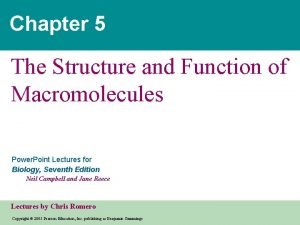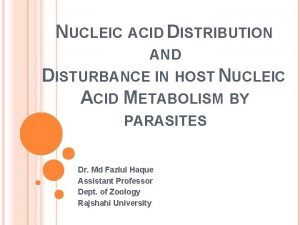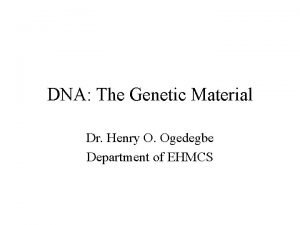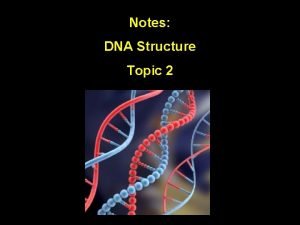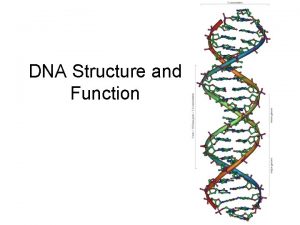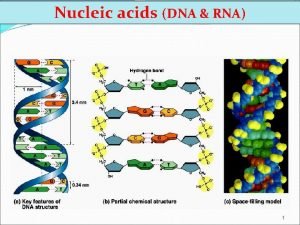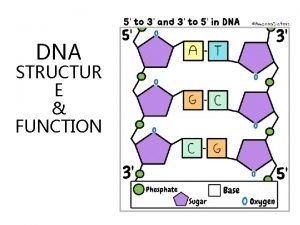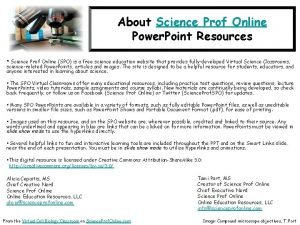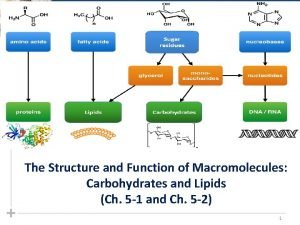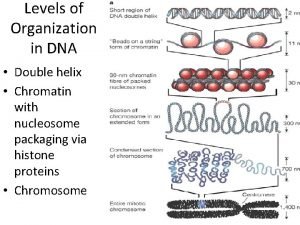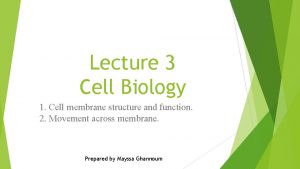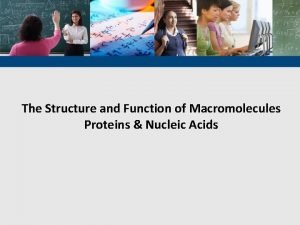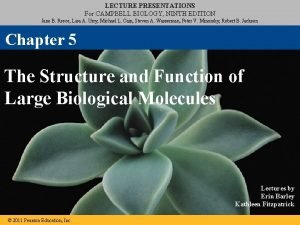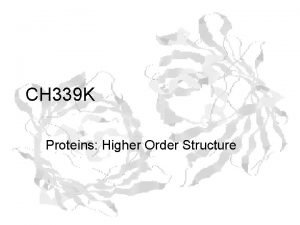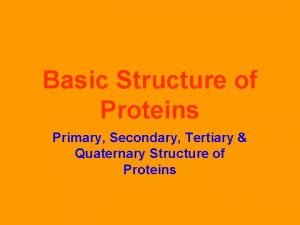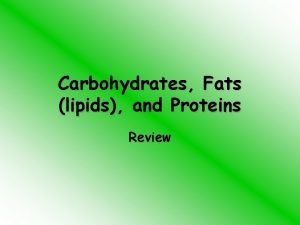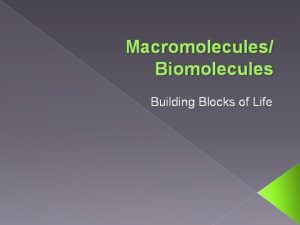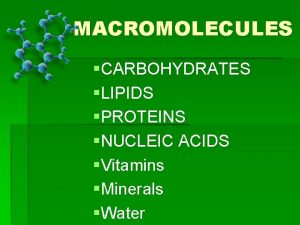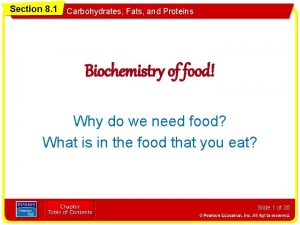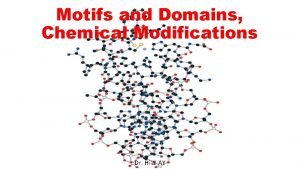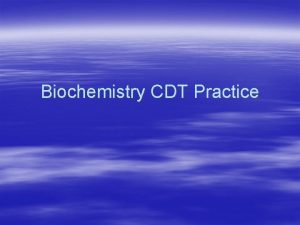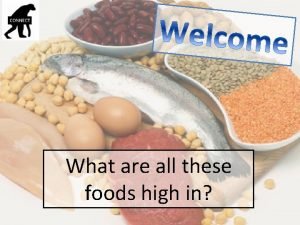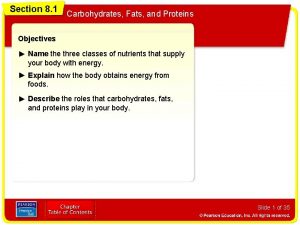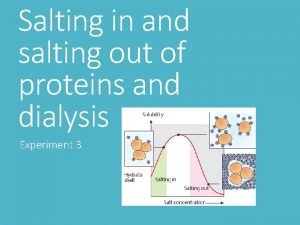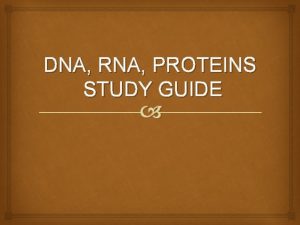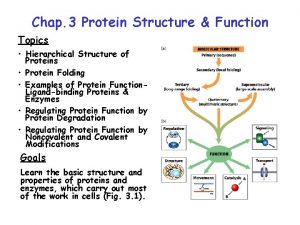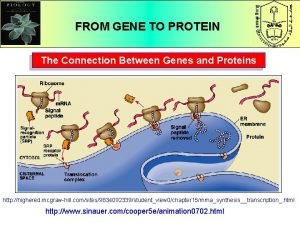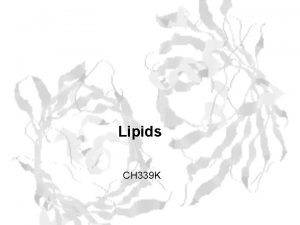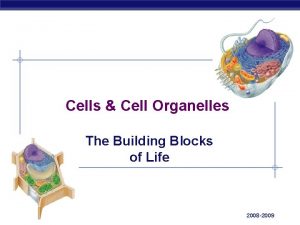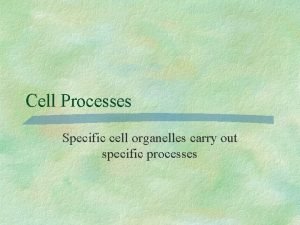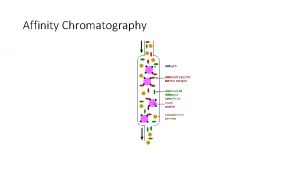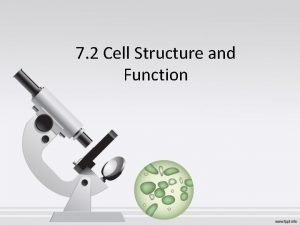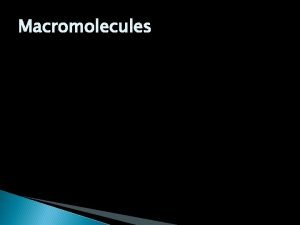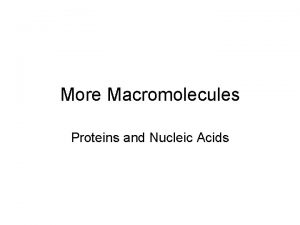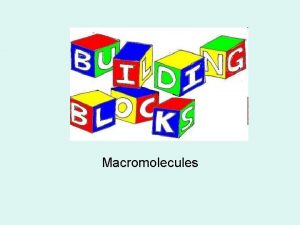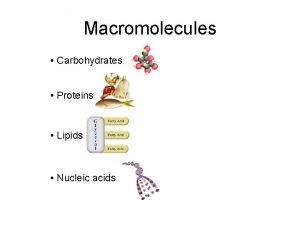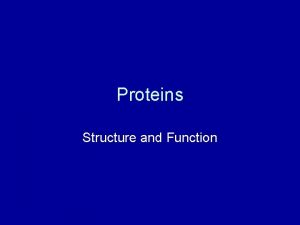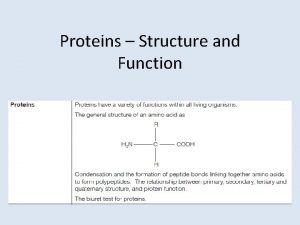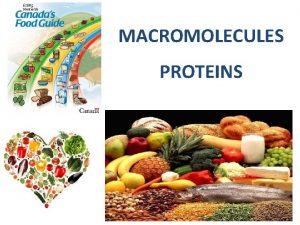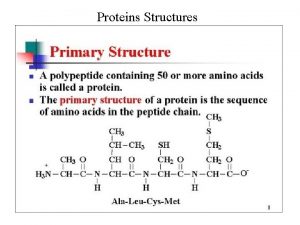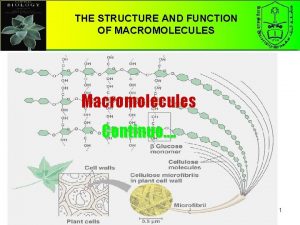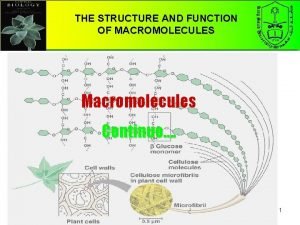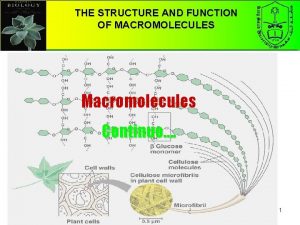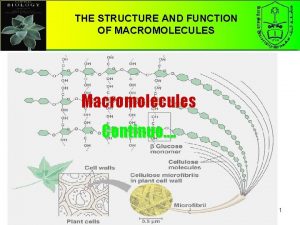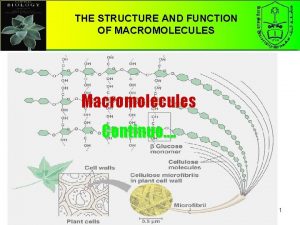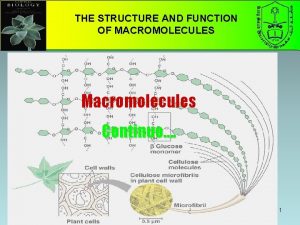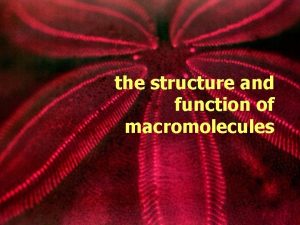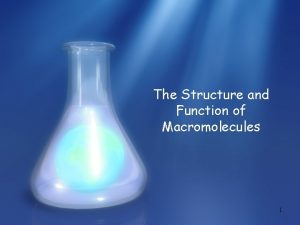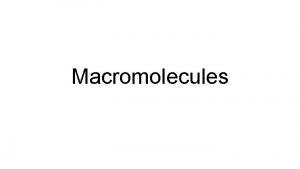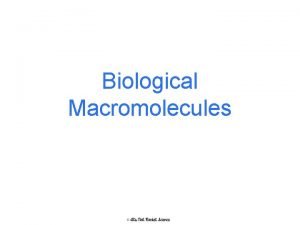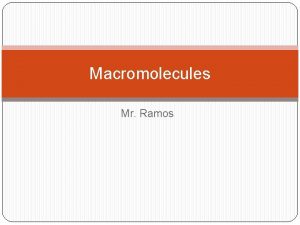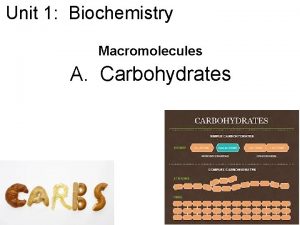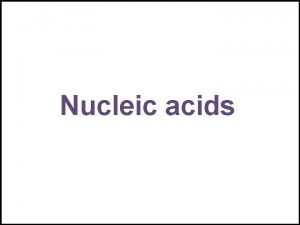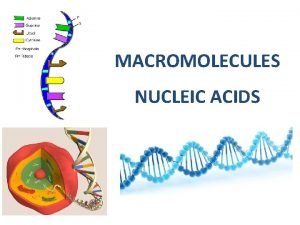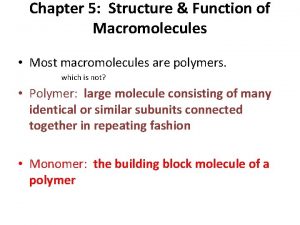The Structure and Function of Macromolecules Proteins Nucleic




































- Slides: 36

The Structure and Function of Macromolecules Proteins & Nucleic Acids

The FOUR Classes of Large Biomolecules • All living things are made up of four classes of large biological molecules: • • Carbohydrates Lipids Protein Nucleic Acids • Macromolecules are large molecules composed of thousands of covalently bonded atoms • Molecular structure and function are inseparable 2

Proteins Come In Many Varieties! • Proteins include a diversity of structures, resulting in a wide range of functions • Proteins account for more than 50% of the dry mass of most cells • Protein functions include structural support, storage, transport, cellular communications, movement, and defense against foreign substances 3

Enzymatic proteins Function: Selective acceleration of chemical reactions Example: Digestive enzymes catalyze the hydrolysis of bonds in food molecules. Enzyme 4

Storage proteins Function: Storage of amino acids Examples: Casein, the protein of milk, is the major source of amino acids for baby mammals. Plants have storage proteins in their seeds. Ovalbumin is the protein of egg white, used as an amino acid source for the developing embryo. Ovalbumin Amino acids for embryo 5

Hormonal proteins Function: Coordination of an organism’s activities Example: Insulin, a hormone secreted by the pancreas, causes other tissues to take up glucose, thus regulating blood sugar concentration High blood sugar Insulin secreted Normal blood sugar 6

Defensive proteins Function: Protection against disease Example: Antibodies inactivate and help destroy viruses and bacteria. Antibodies Virus Bacterium 7

Transport proteins Function: Transport of substances Examples: Hemoglobin, the iron-containing protein of vertebrate blood, transports oxygen from the lungs to other parts of the body. Other proteins transport molecules across cell membranes. Transport protein Cell membrane 8

Receptor proteins Function: Response of cell to chemical stimuli Example: Receptors built into the membrane of a nerve cell detect signaling molecules released by other nerve cells. Signaling molecules Receptor protein 9

Structural proteins Function: Support Examples: Keratin is the protein of hair, horns, feathers, and other skin appendages. Insects and spiders use silk fibers to make their cocoons and webs, respectively. Collagen and elastin proteins provide a fibrous framework in animal connective tissues. Collagen Connective tissue 60 m

More About Enzymes • Enzymes are a type of protein that acts as a catalyst to speed up chemical reactions • Enzymes can perform their functions repeatedly, functioning as workhorses that carry out the processes of life 11

Amino Acids: Yet Another Monomer • Amino acids are organic molecules with carboxyl and amino groups • Amino acids differ in their properties due to differing side chains, called R groups Side chain (R group) carbon Amino group Carboxyl group 12

Polypeptides • Polypeptides are unbranched polymers built from the same set of 20 amino acids • A protein is a biologically functional molecule that consists of one or more polypeptides 13

Hydrophobic: Therefore retreat from water! Nonpolar side chains; hydrophobic Side chain Glycine (Gly or G) Methionine (Met or M) Alanine (Ala or A) Valine (Val or V) Phenylalanine (Phe or F) Leucine (Leu or L) Tryptophan (Trp or W) Isoleucine (Ile or I) Proline (Pro or P)

Hydrophilic: Therefore Attracted to Water 15

Hydrophilic: But Electrically Charged! 16

Peptide Bonds • Amino acids are linked by peptide bonds • A polypeptide is a polymer of amino acids • Polypeptides range in length from a few to more than a thousand monomers (Yikes!) • Each polypeptide has a unique linear sequence of amino acids, with a carboxyl end (C-terminus) and an amino end (N-terminus) 17

Peptide Bonds 18

Peptide Bonds 19

Protein Structure & Function • At first, all we have is a string of AA’s bound with peptide bonds. • Once the string of AA’s interacts with itself and its environment (often aqueous), then we have a functional protein that consists of one or more polypeptides precisely twisted, folded, and coiled into a unique shape • The sequence of amino acids determines a protein’s three-dimensional structure • A protein’s structure determines its function 20

Protein Structure: 4 Levels • Primary structure consists of its unique sequence of amino acids • Secondary structure, found in most proteins, consists of coils and folds in the polypeptide chain • Tertiary structure is determined by interactions among various side chains (R groups) • Quaternary structure results when a protein consists of multiple polypeptide chains 21

Primary Structure • Primary structure, the sequence of amino acids in a protein, is like the order of letters in a long word • Primary structure is determined by inherited genetic information

Secondary Structure • The coils and folds of secondary structure result from hydrogen bonds between repeating constituents of the polypeptide backbone • Typical secondary structures are a coil called an helix and a folded structure called a pleated sheet 23

Secondary Structure

Tertiary Structure • Tertiary structure is determined by interactions between R groups, rather than interactions between backbone constituents • These interactions between R groups include actual ionic bonds and strong covalent bonds called disulfide bridges which may reinforce the protein’s structure. • IMFs such as London dispersion forces (LDFs a. k. a. and van der Waals interactions), hydrogen bonds (IMFs), and hydrophobic interactions (IMFs) may affect the protein’s structure 25

Tertiary Structure 26

Quaternary Structure • Quaternary structure results when two or more polypeptide chains form one macromolecule • Collagen is a fibrous protein consisting of three polypeptides coiled like a rope 27

Quaternary Structure • Hemoglobin is a globular protein consisting of four polypeptides: two alpha and two beta chains 28

Four Levels of Protein Structure Revisited 29

Sickle-Cell Disease: A change in Primary Structure • A slight change in primary structure can affect a protein’s structure and ability to function • Sickle-cell disease, an inherited blood disorder, results from a single amino acid substitution in the protein hemoglobin “Normal” Red Blood Cells 30

Sickle-Cell Disease: A change in Primary Structure • A slight change in primary structure can affect a protein’s structure and ability to function • Sickle-cell disease, an inherited blood disorder, results from a single amino acid substitution in the protein hemoglobin 31

Sickle-Cell Disease: A change in Primary Structure 32

What Determines Protein Structure? • In addition to primary structure, physical and chemical conditions can affect structure • Alterations in p. H, salt concentration, temperature, or other environmental factors can cause a protein to unravel • This loss of a protein’s native structure is called denaturation • A denatured protein is biologically inactive 33

Denature: Break Bonds or Disrupt IMFs 34

Nucleic Acids • Nucleic acids store, transmit, and help express hereditary information • The amino acid sequence of a polypeptide is programmed by a unit of inheritance called a gene • Genes are made of DNA, a nucleic acid made of monomers called nucleotides 35

Could Prove Useful 36
 Chapter 5 the structure and function of macromolecules
Chapter 5 the structure and function of macromolecules Function of nucleic acid
Function of nucleic acid Function of nucleic acids
Function of nucleic acids Ehmcs
Ehmcs Molecule of dna labeled
Molecule of dna labeled Nucleic acid monomer
Nucleic acid monomer Dna and rna
Dna and rna Chargaff's rule
Chargaff's rule Nucleic acid dna structure
Nucleic acid dna structure Macromolecule
Macromolecule Nucleic acid structure
Nucleic acid structure Exocytosis definition biology
Exocytosis definition biology Structural proteins function
Structural proteins function Storage proteins function
Storage proteins function Higher order structure of proteins
Higher order structure of proteins Three peptide chains woven like a rope
Three peptide chains woven like a rope How are macromolecules separated or digested
How are macromolecules separated or digested Micromolecules and macromolecules
Micromolecules and macromolecules What macromolecules are in bread olive oil and pasta
What macromolecules are in bread olive oil and pasta Building blocks of macromolecules
Building blocks of macromolecules Are vitamins and minerals macromolecules
Are vitamins and minerals macromolecules Section 8-1 carbohydrates fats and proteins answer key
Section 8-1 carbohydrates fats and proteins answer key Protein domains and motifs
Protein domains and motifs Organic compounds such as proteins and starches are too
Organic compounds such as proteins and starches are too Lbv foods examples
Lbv foods examples Section 8-1 summary carbohydrates fats and proteins
Section 8-1 summary carbohydrates fats and proteins Salting out proteins
Salting out proteins Secondary structure of protein
Secondary structure of protein Dna rna and proteins study guide answers
Dna rna and proteins study guide answers Protein structure
Protein structure What is the connection between genes and proteins
What is the connection between genes and proteins Integral and peripheral proteins
Integral and peripheral proteins Peptides and proteins
Peptides and proteins Endoplasmic reticulum factory part or worker
Endoplasmic reticulum factory part or worker Does exocytosis require energy
Does exocytosis require energy Mobile phase in affinity chromatography
Mobile phase in affinity chromatography Rough endoplasmic reticulum function
Rough endoplasmic reticulum function
